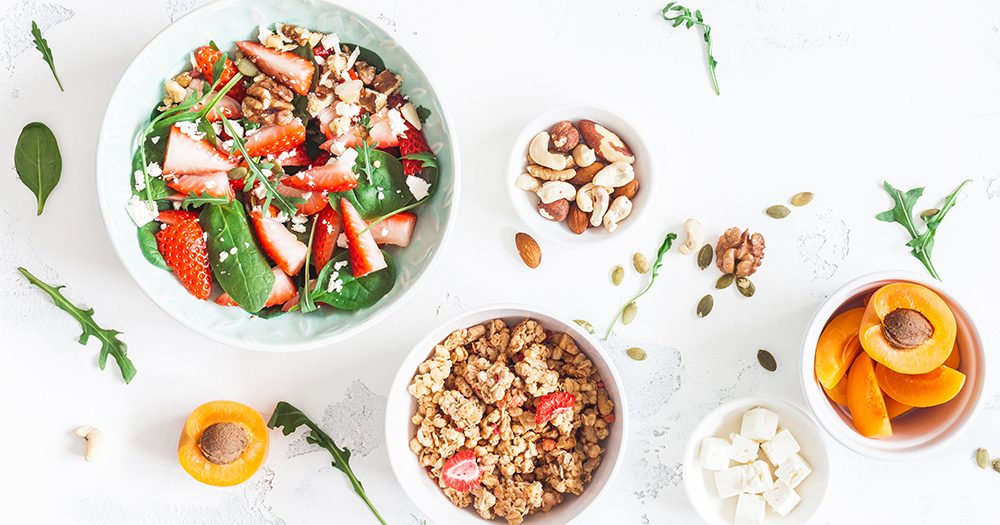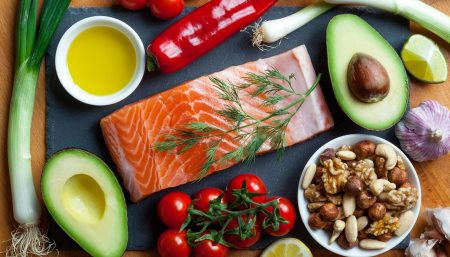
5:2 diet
The 5:2 diet, also written as 5/2 diet, is a fad diet which involves severe calorie restriction for two non-consecutive days a week and normal eating the other five days, which originated and became popular in the UK, and spread in Europe and to the USA. It is a form of intermittent fasting. The diet is claimed to promote weight loss and to have several beneficial effects on health. According to the UK National Health Service there is limited evidence on the safety and effectiveness of the diet; they advise people considering it to consult their doctor.
The diet became popular in the UK after the BBC2 television Horizon documentary Eat, Fast and Live Longer was broadcast on 6 August 2012. The diet specifies a low calorie consumption (sometimes described as “fasting”) for two days a week, which should not be consecutive, but allows normal eating for the other five days. Men may eat 600 calories on fasting days, and women 500. A typical fasting day may include a breakfast of 300 calories, such as two scrambled eggs with ham, water, green tea, or black coffee, and a lunch or dinner of grilled fish or meat with vegetables, amounting to 300 calories. The daily 500 or 600 calorie limit requires small portions.
The UK National Health Service posted a detailed article on the diet on its website citing limited evidence for weight loss in humans, and a lack of good evidence for increasing lifespan, improving cognitive decline, and prolonging life in humans in real life (as opposed to animal and laboratory results). The conclusion was: “compared to other types of weight loss programmes the evidence base of the safety and effectiveness of the 5:2 diet is limited. If you are considering it then you should first talk to your GP to see if it is suitable for you.”
Mosley’s book, The Fast Diet (co-written with Mimi Spencer), became the top selling book in the United Kingdom in February 2013. The Complete 5:2 Diet App (by Papertrell and HarperCollins) became the top selling Diet app in the United Kingdom in September 2013.
Intermittent Fasting does not mean stopping eating entirely. It means reducing the amount you eat, but only for quite short periods of time. In The Fast Diet book it is outline experiences of trying different forms of intermittent fasting, before settling on what I called a 5:2 regime. With 5:2 intermittent fasting you eat normally five days a week and diet two days a week, cutting your calorie intake for those two days to a ¼ of their normal level. This means that on, say, a Monday and a Thursday you will eat 500 calories if you are a woman, 600 if you are a man.
If you stick to this plan then you should lose around 1lb (0.46kg) a week if you are a woman, slightly more for a man. Success also depends on not over-eating on your normal days. You should not only lose weight but also enjoy a wide range of health benefits. Studies of intermittent fasting show that not only do people see improvements in blood pressure and their cholesterol levels, but also in their insulin sensitivity.
As one of the medical experts interviewed put it: ‘There is nothing else you can do to your body that is as powerful as fasting.’
If we were to distill the Fast Diet into a single sound-bite, it would all come down to 5:2. That’s five days of normal eating, with little thought to calorie control and a slice of pie for pudding if that’s what you want. Then, on the other two days, you just eat a quarter of your recommended daily calorie quota. That works out at 500 calories for women and 600 for men. This was Michael’s method for improving his health and losing over 20 pounds in 2012. I followed his plan, and dropped the same amount, losing two dress sizes and four inches from my waist measurement in the process.
DODO diet
A top Olympic nutritionist has devised the DODO plan, a revolutionary Day On/Day Off eating schedule. Even if you haven’t tried fasting before the chances are you will be familiar with the concept. The 5:2 fasting diet was the most talked about weight loss plan of 2013. It promised that those who stuck to 500 calories a day for two days a week could eat what they liked on the remaining five days and still lose weight.
Now a new type of fasting diet has launched which not only delivers better results but is much simpler to maintain. By following the plan you can expect to lose up to 7lb in the first week and 1lb to 3lb in subsequent weeks. The DODO, or Day On/Day Off, diet is based around the principles of intermittent fasting (IF) but takes a different approach which completely cuts out the need for tiresome calorie counting.
Intermittent fasting is an umbrella term for a range of different ways to use occasional breaks in food intake to tweak your body’s software, controlling how it repairs and maintains itself and uses energy stores, including fat. While most IF diets, such as the popular 5:2, allow you to eat a limited amount of calories throughout a fasting day, when following DODO you don’t eat at all for 20 to 24 hours to give your body a complete break.
This may sound difficult but the good news is that the time period involved includes the hours we are asleep. The night before a fast day you eat your evening meal between 7pm and 10pm (the pre-fast meal), then the fasting process starts while you sleep and continues until the following evening when you eat one mid-fast meal, which must be consumed no later than 24 hours after the pre-fast meal.
The following morning you eat a special morning meal, called the break-fast, to end the period of fasting. You should do no more than three fasting days per week and must always have a break in between each one. The more fasting days you do the more weight loss you will enjoy. The diet’s creator Drew Price says the advantages of not eating for 24 hours far outweigh being able to nibble on 500 calories throughout the day.
“The body is able to control how it uses different energy fuels such as fats, proteins and carbohydrate,” explains Drew. “It burns the one it has the biggest supply of which means in times of fasting it favours fat over its carbohydrate stores. The DODO diet involves a complete fast because even if you have a few grams of carbohydrate or protein the body flicks the switch from fasting mode to feeding mode so you lose the benefits of having a break from eating.”
 Drew goes on to state that eating multiple meals to make up 500 calories can lead to issues that can in the longer term make sticking to the plan far more problematic. “When people eat multiple small meals the amount of total calories they consume on the fasting day often gradually increases,” he says. “After an initial strict period people become lax when it comes to the painful task of calorie counting everything.
Drew goes on to state that eating multiple meals to make up 500 calories can lead to issues that can in the longer term make sticking to the plan far more problematic. “When people eat multiple small meals the amount of total calories they consume on the fasting day often gradually increases,” he says. “After an initial strict period people become lax when it comes to the painful task of calorie counting everything.
“With my diet you don’t have to think about food or calories.” Drew has come up with clear guidelines about what to eat for the pre-fast, mid-fast and break-fast meals.
It is as simple, for example, as eating a palm-sized portion of protein such as chicken, plus two cupped handfuls of vegetables and a fist-sized portion of carbohydrates such as wholewheat pasta.
Drew, 37, who studied biochemistry at university and works as a nutritionist in London, first felt the need for an easy-to-follow eating plan while working as an investment banker in Canary Wharf from 2000 to 2004. Having worked in the City I know what it’s like to try to stay fit and healthy while juggling a full-time job,” says Drew. “My personal trainer knew I had an interest in health and nutrition and encouraged me to study for the Personal Training Certification from the American College of Sports Medicine.”
Drew threw himself into a year of lectures, exams and revision and as well as achieving the qualification he developed a passion for nutrition. “The more I read about nutrition the more interested I became in it,” he says. While there were short nutrition courses available Drew wanted to get the best possible training. And in 2004 he made the life-changing decision to quit his high-flying job in London and travel to Australia to study for a Masters degree in nutrition. After graduating he moved back to the UK where he started working as a nutritionist. Drew went on to become a consultant for top Olympic athletes and now counts Chelsea Football Club among a highly impressive client list.
Constant grazing means we put on weight because the rate at which we produce and store fat outstrips the rate at which we use it for fuel. The DODO diet is designed to encourage the body to use up these fat stores as fuel. As well as taking in fewer calories, fasting has been shown to improve cell function and regulate insulin production, leading to a smaller waistline. It also stimulates the growth hormone which burns fat but protects lean muscle mass. Research has shown that a short fast will not slow down your metabolism.
In fact there is evidence to suggest there is a small increase in the rate of calorie usage towards the end of a fast day. Keen to experience the benefits for himself Drew attempted to fast for one day a week, then increased it to two and then three days a week. “I was already pretty lean but I became leaner while retaining my muscle mass,” says Drew, who then tried out the diet on a select group of friends and clients whom he monitored closely. “The only rule I gave them was that it had to be a complete fast,” he says. “When a few people said they were eating more the day after a fast I tweaked what they were eating for the mid-fast meal to keep them fuller for longer.”
“My research showed that people wouldn’t overeat the next day. The results were amazing – my friends lost weight and inches easily.” Fashionable fasting diets used by celebrities were actually invented by monks and hermits in the Middle Ages, it has been revealed. There is a direct link between the 5:2 and DODO diets followed by stars such as Beyoncé and Benedict Cumberbatch and the spiritual eating habits devised hundreds of years ago to cleanse the mind and body. Andrew Jotischky, Medieval History Professor at Lancaster University, is the author of ‘A Hermit’s Cookbook’ which has recipes from the Middle Ages including stew and bread soup.
The monks’ healthy, simple diet and their fasting habits are almost exactly the same as today’s celebrity weight loss plans, says the professor. The idea behind the 5:2 diet is to eat normally for five days, while fasting on the other two days. It is suggested that the dieter limits themself to 500 calories for two non-consecutive days a week.
However, they are given a free reign on their choice of food for the other five days. Some studies suggest fasting once or twice a week can also protect the brain against illnesses such as Alzheimer’s disease.
The DODO – or Day On Day Off diet – follows a similar theory. The lecturer in Lancaster University’s History Department has produced a detailed look at fasting and diet in the Middle Ages. He believes the way the monks found, prepared and ate their food contains lessons that can – and are – being used in modern life. Professor Jotischky said: ‘Hermits went out and found their food in the wild or grew it themselves. ‘In that respect they were very similar to some of today’s chefs, like Hugh Fearnley-Whittingstall, who use the same approach to prepare their dishes.
‘And of course, fasting played a major part in their lives. For them it was a spiritual act rather than a way to lose weight, but it made them very aware of the nature of food and eating. ‘As we have seen with recent dieting fads, we still look at fasting as a way of cleansing and improving our minds and our bodies. ‘There are great similarities between the hermits’ and monks’ diets and today’s current trendy weight-loss regimes.
‘The way they ate has a very modern dimension, and the superiority of home-grown and locally picked food is an argument they would have been very familiar with. ‘They would also be familiar with the debate over concerns over “food miles”. Monks and hermits gathered their food from nature. ‘They also recognised the virtue of a diet of simple food that needed little or no preparation.’
Disclaimer
The Content is not intended to be a substitute for professional medical advice, diagnosis, or treatment. Always seek the advice of your physician or other qualified health provider with any questions you may have regarding a medical condition.
